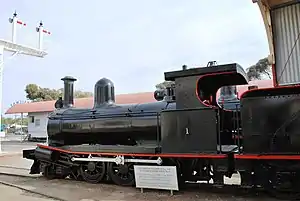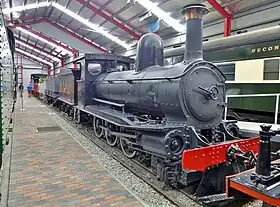| Silverton Tramway Y class | |||||||||||||||||||||||||||||||
|---|---|---|---|---|---|---|---|---|---|---|---|---|---|---|---|---|---|---|---|---|---|---|---|---|---|---|---|---|---|---|---|
 Y1 preserved at Sulphide Street Museum, 2009 | |||||||||||||||||||||||||||||||
| |||||||||||||||||||||||||||||||
| |||||||||||||||||||||||||||||||
| |||||||||||||||||||||||||||||||
| |||||||||||||||||||||||||||||||
The Silverton Tramway Y class was a class of 2-6-0 and 2-6-2T steam locomotives of the Silverton Tramway Company, operating between Broken Hill, New South Wales, and the border of South Australia.
History
Between 1888 and 1907 the Silverton Tramway Company took delivery of eighteen 2-6-0 and two 2-6-2T locomotives from Beyer, Peacock & Co, Manchester, and two built by James Martin & Co purchased second-hand from the Tarrawingee Tramway.[1][2][3]
The company notionally had 21 Y class locomotives, although three were never operated and only a maximum of 17 were owned at any one time. Their road numbers were recycled.[1][2][3]
In 1887, having commenced operations with hired South Australian Railways Y class locomotives, the company ordered four locomotives of the same design from Beyer, Peacock. They were assembled in Gawler, South Australia by James Martin's Phoenix Foundry. Since the company had an option to sell to the South Australian Railways any that it deemed surplus, two of the locomotives ("1st Y3" and "1st Y4") passed without use. Of the other two, which were 2-6-2T (side tank) locomotives but otherwise the same as the 2-6-0 locomotives, one was sold within a few months; the other was given away as compensation for a collision 11 years later.[4]
Westinghouse air brakes were fitted to Y13, Y15 and Y16 from new and Y1 and Y11 were retrofitted. Y1, Y6, Y8 and Y11 to Y17, which originally had a boiler pressure of 145 pounds per square inch (1000 kilopascals; 10.2 kilograms-force per square centimetre), were rebuilt with 180 pounds per square inch (1200 kilopascals; 13 kilograms-force per square centimetre) boilers and lead adhesion slabs were added to the running boards. Three were superheated between 1924 and 1926.[1]
The locomotives were superseded on main line duties by the A class from 1912 onwards, but many were retained for shunting and secondary duties around the Broken Hill yards and mine sidings. The last was withdrawn in 1961.[1][3]

Disposition
The locomotives' disposition as of 2015 is shown in the table.
|
Preservation
- Y1: at Sulphide Street Museum[5]
- Y6: at Mount Laura Homestead Museum[6]
- Y11: at Penrose Park, Silverton in September 1965[8]
- Y12: at the National Railway Museum, Port Adelaide[3][9]
References
- 1 2 3 4 McNicol, Steve (1981). Silverton Tramway Locomotives. Elizabeth Downs: Railmac Publications. pp. 7/8. ISBN 0 959415 30 0.
- 1 2 Oberg, Leon (2010). Locomotives of Australia 1850s-2010. Dural: Rosenberg Publishing. pp. 65/66. ISBN 9781921719011.
- 1 2 3 4 5 Y1 National Railway Museum
- ↑ Roberts, Lew (1995). Rails to wealth. Melbourne: Lew E. Roberts. p. 271. ISBN 0646265873.
- 1 2 Y1 Australian Steam
- 1 2 Narrow Gauge no. 0 2-6-2 Tank Locomotive Chris's Commonwealth Railways Information
- ↑ BHP Whyalla No.2 Australian Steam
- 1 2 Y11 Australian Steam
- 1 2 Y12 Australian Steam